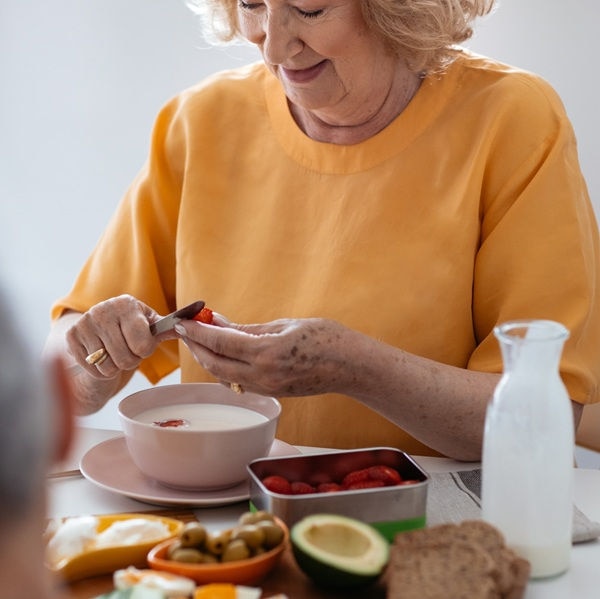
3 December 2025
News
August 13, 2025
Discover solutions to boost oral nutritional supplement (ONS) adherence, including research-backed strategies.
Medical nutrition is designed to support and transform health outcomes for those most in need, from individuals living with health conditions to those navigating age-related changes or challenges. But despite its therapeutic potential, poor adherence to specialty nutrition regimens, specifically oral nutritional supplements (ONS), can limit the effectiveness of nutritional interventions. In fact, ONS compliance differs significantly between patients, with a systematic review of 46 studies revealing that compliance varied between 37 and 100%.1 The reasons for this low and variable compliance are multifaceted. Yet, adherence is typically measured only by supplement intake. Thus, overlooking the complex factors and behaviors that influence a patient’s motivation and ability to follow their nutritional regimen, such as volume and flavor fatigue, TSAs, reduced appetite, and much more.
Keep reading to explore these complexities and discover the scientific insights and promising solutions that can help improve patient adherence.
Adherence is a multidimensional concept that encompasses not only the quantity of supplement intake, but also the timing and consistency of intake combined with the following factors:2
Contextual: This comprises the external environment and support systems in place, including healthcare staff guidance, proper administration protocols, social dynamics during consumption, family support, and the timing and setting of supplement intake.
Personal: The focus here is on individual patient characteristics such as their attitudes and motivations toward the supplements, desire for independence, quality of life goals, consumption preferences (like using straws or specific temperatures), and physiological changes related to aging that affect taste and smell.
Product: This relates to the specific characteristics of the nutritional supplement, including sensory properties like taste, aroma and texture, which might trigger acceptance or rejection.
Figure adapted from Lester, S.M. et al (2022).2
To better understand what influences a patient's compliance with oral nutritional supplements, a systematic review was conducted, comprising 2,282 people, for the duration of consumption (4 to 365 days).1 Surprisingly, compliance did not correlate with the duration of ONS intervention. Nor was there a difference in compliance between studies that reported giving instruction on when to take the ONS (78%) compared to studies that did not give instruction (79%). This suggests that patients are not experiencing supplement fatigue or a lack of guidance. So, what is affecting compliance?
A significant negative correlation was found between ONS and average patient age, meaning that older patients are less likely to adhere to their specialty nutrition regimens.1 In comparison, the type of medical indication did not correlate with compliance. This highlights the importance of developing age-specific strategies and support systems and formats to help older adults maintain consistent supplement intake and achieve better health outcomes. It’s also important to note that this age group can have more rigid dietary regimens, highlighting the need for flexible solutions that can fit into their current dietary habits and preferences.
Research reveals that the energy density of oral nutritional supplements impacts adherence. ONS with a high energy density of >2 kcal/ml resulted in significantly higher compliance (91%) compared to supplements with an energy density of 1.5 kcal/ml (78%) or 1-1.3 kcal/ml (77%), as shown in Figure 1.1
Graphic adapted from Hubbard, Gary P. et al (2012).1
This result is likely due to the smaller volumes of nutritional supplement needed for a higher energy density format. Patients may also be experiencing volume fatigue, where they cannot finish standard 200–400 mL servings, especially when appetite is compromised. This is common for those going through chemotherapy, as patients with cancer often report that the amount of ONS is too much, or that they feel full before finishing it. This challenge is also observed in older adults experiencing anorexia of aging. Additional studies have found that high-volume ONS formats can lead to poor compliance rates, sometimes less than 50%, even when prescribed.3 The size of oral nutritional supplements is therefore key when it comes to improving adherence rates.
While size matters, the most important factor for oral nutritional supplements preference and adherence is taste. No one wants to eat unpleasant tasting foods, and it is therefore no surprise that great tasting ONS results in better compliance. In fact, research reveals that studies using a variety of flavors in their ONS resulted in significantly greater compliance (81%) compared to studies using a variety of ONS types (63%).1 Flavor plays a central role in the sensory enjoyment of foods and beverages in addition to governing appetite and intake. In fact, enhancing taste and aroma in foods for the elderly or medically compromised has been shown to improve palatability, increase food intake, boost salivary flow, and support immune response.4 However, several undesirable sensory attributes, such as bitterness, off-notes, unpleasant after-tastes and mouth-effects, stem from nutritional ingredients used in ONS formulations and their processing—leading to reduced adherence.5 For instance, sulfurous flavors have a negative impact on consumer acceptance of dairy ONS beverages.2
Flavor is influenced by the complex interaction between factors inherent to the product (undesirable sensory attributes) and factors intrinsic to the patient (sensory abilities). Take cancer patients as an example. Up to 80% of cancer patients are malnourished or at risk of malnutrition, which can significantly impact their quality of life and health outcomes.6,7 Yet, the effectiveness of ONS depends on the acceptability of the nutritional product and therefore patient compliance, which can be challenging.8,9 Evidence confirms that 20-86% of cancer patients have taste alteration and 5-60% experience smell alterations.10 For instance, between 9.7% and 78.0% of patients with various cancers, chemotherapy treatments, and treatment phases experience a metallic taste.11 These TSAs can negatively impact food enjoyment and nutrient intake, further increasing the risk of malnutrition.10
One cancer patient revealed: “My appetite—once my life, as a food writer and presenter—vanished. I subsisted entirely on beige blandness: boiled potatoes, crustless toast, sliced apples. I couldn't stomach even the thought of flavor. Cancer turned food into ash”.12
The emotional and psychological impact of TSAs can further suppress appetite and motivation to adhere to nutritional interventions.13 A cross-sectional study involving head and neck cancer patients found that 35% experienced loss of appetite, which was a major contributor to reduced dietary intake.14 This symptom, amongst others, can lead to decreased energy and protein intake from ONS (Dai et al. 2023). Data shows that up to 66% of cancer patients do not meet expert recommended protein intake levels.15
The current ONS landscape mainly focuses on nutritional value, which may have neglected an important aspect—the enjoyment of food intake. It’s time to change that. Based on the findings from ONS adherence research, there are several promising opportunities to improve not only patient experience, but ultimately, compliance:
People-centered care: Prioritizing a food first approach is key to empowering people to incorporate solutions into their existing preferred foods and dietary regimens. What’s more, adopting the perspectives of individuals, carers, families, and communities, and focusing on the needs of people rather than specific diseases, is central to improving compliance. For elderly patients, this means providing tailored support—such as involving caregivers in supplement routines and creating ONS with familiar flavors and textures. Personalized strategies, like reminder systems or social mealtime settings, can also help older adults maintain consistent intake and feel empowered in their nutritional journey.
Taste and sensory solutions: Boosting the sensory appeal and experience of ONS and providing greater variety and flexibility of flavor solutions is a strong approach to improving compliance. This strategy has been shown to improve palatability, increase food intake, boost salivary flow, and support immune response.4 Our Taste and Sensory experts are experienced in matching taste receptor science with molecular masking solutions to tackle and solve even the hardest of taste challenges, such as removing off notes.
Novel formats: With volume being a key barrier to ONS compliance, creating smaller formats that are easier to consume is key to championing better adherence. For instance, we’ve created a unique ONS format that makes protein intake enjoyable and convenient with Mix-in protein granules powered by Sprinkle It Technology™ (SIT™). This patent-pending format has a high protein density and small volume, making it easy to incorporate into daily meals, snacks or semi-liquid beverages, such as smoothies. Thanks to this flexibility, it encourages a food first approach which is a key strategy for improving adherence to nutritional regimens.
At dsm-firmenich, we take a purpose-led approach to innovation in oral nutritional supplements. We uniquely combine world-leading taste expertise with best-in-class premix capabilities, innovative formats, and science-backed novel ingredients to co-create enjoyable nutrition solutions for those who need them most. This means leveraging taste-masking solutions to address unpleasant off-notes and aftertastes, designing formats that fit real lives and preferences, formulating with cutting-edge ingredients proven to enhance health outcomes, and applying technologies that deliver meaningful benefits with less volume. Plus, with our global market knowledge and local insights, we can support medical nutrition brands in bringing next-generation nutritional solutions from ideation to concept—and beyond.
1. Hubbard, Gary P., Marinos Elia, Anne Holdoway, and Rebecca J. Stratton. "A systematic review of compliance to oral nutritional supplements." Clinical nutrition 31, no. 3 (2012): 293-312.
2. Lester, S., M. Kleijn, L. Cornacchia, L. Hewson, M. A. Taylor, and Ian Fisk. "Factors affecting adherence, intake, and perceived palatability of oral nutritional supplements: a literature review." The journal of nutrition, health & aging 26, no. 7 (2022): 663-674.
3. van Bokhorst–de van der Schueren, Marian AE, Martin M. Roosemalen, Peter JM Weijs, and Jacqueline AE Langius. "High waste contributes to low food intake in hospitalized patients." Nutrition in Clinical Practice 27, no. 2 (2012): 274-280.
4. Schiffman, S. S., and B. G. Graham. "Taste and smell perception affect appetite and immunity in the elderly." European journal of clinical nutrition 54, no. 3 (2000): S54-S63.
5. Lester. S. PhD Thesis 2021. Div. Food, Nutr & Dietetics. University of Nottingham UK
6. Bossi, Paolo, Raffaele De Luca, Oriana Ciani, Elisa D’Angelo, and Riccardo Caccialanza. "Malnutrition management in oncology: An expert view on controversial issues and future perspectives." Frontiers in oncology 12 (2022): 910770.
7. Pressoir, M., S. Desné, D. Berchery, G. Rossignol, B. Poiree, M. Meslier, S. Traversier et al. "Prevalence, risk factors and clinical implications of malnutrition in French Comprehensive Cancer Centres." British journal of cancer 102, no. 6 (2010): 966-971.
8. Ravasco, Paula, Isabel Monteiro-Grillo, Pedro Marques Vidal, and Maria Ermelinda Camilo. "Dietary counseling improves patient outcomes: a prospective, randomized, controlled trial in colorectal cancer patients undergoing radiotherapy." Journal of clinical oncology 23, no. 7 (2005): 1431-1438.
9. Hogan, Sophie E., Michael J. Solomon, and Sharon K. Carey. "Exploring reasons behind patient compliance with nutrition supplements before pelvic exenteration surgery." Supportive Care in Cancer 27, no. 5 (2019): 1853-1860.
10. Rosati, Davide, Pierluigi Mastino, Martina Romeo, Giulia de Soccio, Daniele Pentangelo, Carla Petrella, Christian Barbato, and Antonio Minni. "Taste and smell alterations (TSAs) in cancer patients." Diseases 12, no. 6 (2024): 130.
11. IJpma, Irene, Remco J. Renken, Gert J. Ter Horst, and Anna KL Reyners. "Metallic taste in cancer patients treated with chemotherapy." Cancer treatment reviews 41, no. 2 (2015): 179-186.
12. The Times. “I was fit and healthy. Then I got testicular cancer at 26” Available at: https://www.thetimes.com/life-style/health-fitness/article/testicular-cancer-at-26-experience-flt90q6gn?msockid=26bb45f97c396e64038f513d7d3f6fbb
13. Epstein, Joel B., and Andrei Barasch. "Taste disorders in cancer patients: pathogenesis, and approach to assessment and management." Oral oncology 46, no. 2 (2010): 77-81.
14. Dai, Tingting, Jinli Xian, Xuemei Li, Zhiqiang Wang, and Wen Hu. "Effect of nutrition impact symptoms on oral nutritional supplements energy intake and use days in patients with head and neck cancer: A cross‐sectional study." Cancer Medicine 13, no. 10 (2024): e7288.
15. Stobäus, Nicole, Manfred J. Müller, Susanne Küpferling, Jörg-Dieter Schulzke, and Kristina Norman. "Low recent protein intake predicts cancer-related fatigue and increased mortality in patients with advanced tumor disease undergoing chemotherapy." Nutrition and cancer 67, no. 5 (2015): 818-824.
Ready to close the special nutrition compliance gap?

3 December 2025

3 October 2025

30 September 2025
Customized blends of functional ingredients in one single, efficient premix.
Streamline your product development process and get to market faster.
From trade shows to conferences and other industry events, find out where you can meet us next.
Talking Nutrition, Health & Care
Explore new science, consumer insights, industry news and more in our latest articles.
Discover educational whitepapers, webinars, publications and technical information.
Request samples, place orders and view product documentation.